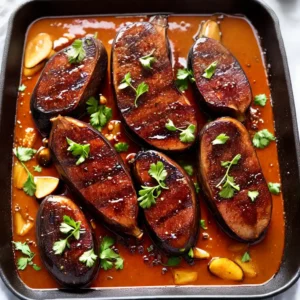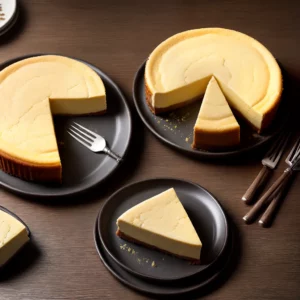How to Cut Mushrooms
Are you looking to master the art of cutting mushrooms? In this step-by-step guide, I will take you through various mushroom cutting techniques to help you perfect your culinary skills.
How to Cut Mushrooms – Key Takeaways:
- Clean mushrooms by wiping them with a damp paper towel to remove dirt.
- Avoid rinsing or submerging mushrooms in water to prevent them from becoming mushy.
- To slice mushrooms, place them cap side up on a cutting board and make even, thin slices.
- For quartered mushrooms, slice in half, rotate, and slice in half again.
- Cube mushrooms by slicing into 1/4-inch thick sections and chopping them into cubes.
- Dice mushrooms by slicing them, cutting slices into matchsticks, and then dicing the matchsticks into small pieces.
- Choose a sharp chef’s knife, utility knife, or paring knife for cutting mushrooms.
- Store fresh mushrooms in a vented container lined with a paper towel in the refrigerator.
- Mushrooms are a good source of vitamin D, zinc, and potassium.
Now that you have a better understanding of mushroom cutting techniques, you can confidently incorporate them into your cooking. Whether you’re slicing, quartering, dicing, or using other creative cuts, mushrooms add a delicious texture and flavor to a wide range of dishes. Remember to choose a suitable knife, clean mushrooms properly, and store them correctly for optimal results. Enjoy exploring the culinary possibilities of mushrooms and their nutritional benefits as you elevate your cooking skills!
Why Mushroom Cutting Skills Matter in the Kitchen
Having solid mushroom cutting skills is crucial in the kitchen, as it can significantly impact the efficiency and outcome of your culinary creations. Whether you’re a professional chef or a home cook, mastering the art of mushroom cutting can elevate your dishes to new heights. From enhancing the presentation to optimizing their texture and flavor, proper mushroom cutting techniques are essential.
First and foremost, efficient mushroom cutting will save you time in the kitchen. With the right techniques, you can quickly slice, dice, or quarter mushrooms without compromising on precision. This allows you to focus on other tasks and ensures that your cooking process flows smoothly. It can be especially handy when preparing large quantities or when time is of the essence.
Furthermore, knowing how to cut mushrooms properly can enhance the visual appeal of your dishes. Whether you’re garnishing a salad, topping a pizza, or creating a beautiful stir-fry, well-cut mushrooms can make a significant difference. Consistent and uniform slices or perfectly diced pieces will not only make your dishes look more professional but also distribute the mushroom’s flavors more evenly.
Lastly, mastering mushroom cutting techniques opens up a world of culinary possibilities. By learning different hacks, watching tutorials, or following a cutting guide, you can explore various cutting styles and experiment with textures. From thin and delicate slices to chunky quarters or small and uniform dice, each cutting method offers a unique mouthfeel that can elevate your dishes to new levels of deliciousness.
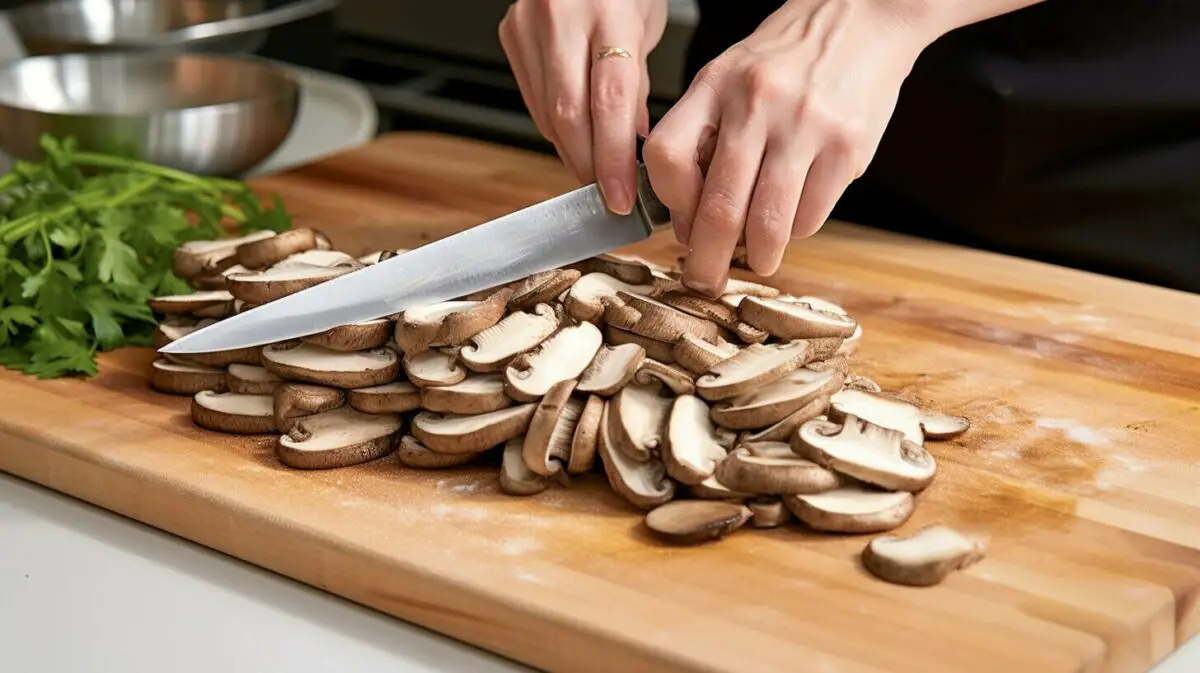
| Mushroom Cutting Techniques | Description |
|---|---|
| Slicing | Evenly cutting mushrooms into thin slices for presentation or sautéing. |
| Quartering | Cutting mushrooms into four pieces, ideal for creating a chunkier texture. |
| Dicing | Cutting mushrooms into small and uniform cubes, perfect for adding to sauces or soups. |
“Proper mushroom cutting techniques can enhance the visual appeal, save time, and expand your culinary repertoire. So sharpen your knife skills, watch a few tutorials, and let your mushroom cutting prowess shine in the kitchen!”
Mushroom Cutting Best Practices
- Use a sharp knife to ensure clean cuts and prevent squashing the mushroom.
- Wipe mushrooms with a damp paper towel instead of rinsing to avoid sogginess.
- Invest in a suitable cutting board to maintain cleanliness and prevent cross-contamination.
- Practice proper knife handling techniques for safe and efficient cutting.
By honing your mushroom cutting skills, you’ll not only enhance your culinary techniques but also elevate your overall kitchen experience. From perfecting the presentation to creating mouthwatering textures, the way you cut mushrooms can truly make a difference in your dishes.
Cleaning Mushrooms: A Necessary First Step
Before diving into the cutting process, it’s essential to start with clean mushrooms. Let’s explore some key steps for cleaning mushrooms effectively.
The first step is to gently wipe the mushrooms with a damp paper towel to remove any dirt or debris. This method is preferred over rinsing or soaking the mushrooms in water, as they tend to absorb moisture and become mushy. By using a paper towel, you can effectively remove any surface dirt without compromising the texture of the mushrooms.
To trim the mushrooms, simply cut off the tough stem at the base. You can also remove any bruised or discolored parts of the mushroom to ensure optimal freshness. It’s important to use a sharp knife for trimming, as it will make the process easier and safer.
When cleaning mushrooms, it’s crucial to maintain cleanliness and hygiene. Use a clean cutting board designated for vegetables and ensure it is free from any traces of meat or other contaminants. This will help prevent cross-contamination and ensure the cleanliness of your mushrooms.
By following these simple steps for cleaning mushrooms, you can ensure that they are ready for the cutting process. Now that your mushrooms are clean and trimmed, you can proceed to cut them into your desired shape and size for your culinary creations!

– Clean mushrooms by gently wiping them with a damp paper towel to remove dirt.
– Trim mushrooms by cutting off the tough stem and removing any bruised or discolored parts.
– Use a sharp knife and a clean cutting board designated for vegetables to maintain cleanliness and prevent cross-contamination.
– Avoid rinsing or soaking mushrooms in water to prevent them from becoming mushy.
| Cleaning Mushrooms: A Necessary First Step |
|---|
| 1. Gently wipe the mushrooms with a damp paper towel. |
| 2. Trim the mushrooms by removing the tough stem and any bruised or discolored parts. |
| 3. Use a sharp knife and a clean cutting board dedicated to vegetables for optimal cleanliness. |
| 4. Avoid rinsing or soaking mushrooms in water to prevent them from becoming mushy. |
Slicing Mushrooms: Thin and Even Cuts
Slicing mushrooms is a fundamental technique that allows you to create thin, even cuts suitable for various culinary applications. Whether you’re preparing a stir-fry, salad, or sautéed mushrooms, mastering the art of slicing can greatly enhance the visual appeal and texture of your dishes.
To slice mushrooms, start by cleaning them with a damp paper towel to remove any dirt or debris. Avoid rinsing or submerging them in water, as mushrooms can absorb moisture and become mushy. Once clean, place the mushrooms on a cutting board with the cap side facing up.
Using a sharp knife, make even, thin slices by applying gentle pressure and maintaining a steady motion. Aim for slices that are around 1/4-inch thick for more delicate applications and up to 1/2-inch thick for heartier dishes. Remember to keep your fingers away from the blade and use a cutting board with a stable surface to ensure safety and precision.
| Mushroom Cutting Method | Slice Thickness |
|---|---|
| Slicing | 1/4 to 1/2-inch thick |
| Quartering | Chunkier texture |
| Dicing | Small and uniform pieces |
“Slicing mushrooms with precision can elevate the visual appeal and texture of your dishes, adding a professional touch to your culinary creations.”
By slicing mushrooms properly, you can achieve consistent cuts that cook evenly and enhance the overall presentation of your meals. These thin and even slices can quickly absorb flavors and cook to perfection in stir-fries, soups, omelets, and other dishes where a delicate texture is desired.
So, the next time you embark on a mushroom-centered culinary adventure, remember the importance of slicing mushrooms with care. Your efforts will be rewarded with beautifully prepared slices that elevate the taste and visual appeal of your creations. Happy slicing!
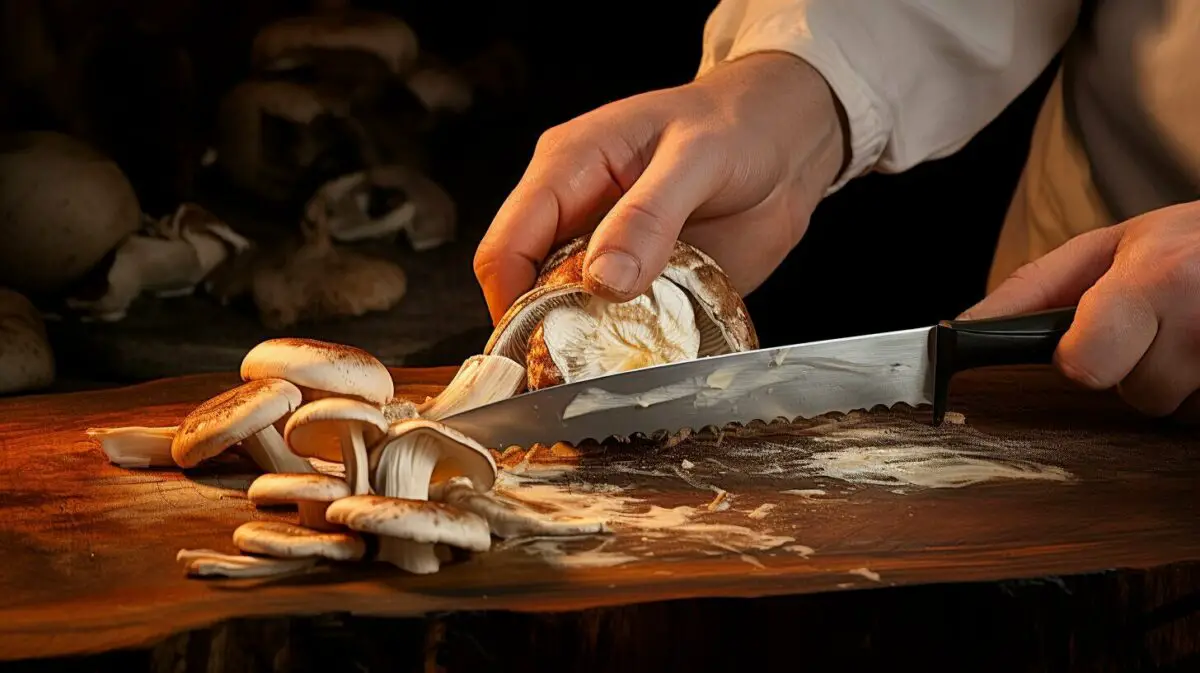
If you prefer a chunkier texture in your dishes, quartering mushrooms is the way to go. Let’s delve into various cutting styles and options.
When quartering mushrooms, it’s important to start with clean mushrooms. Wipe them gently with a damp paper towel to remove any dirt or debris. Remember, rinsing or submerging the mushrooms in water is not recommended, as they can absorb moisture and become mushy.
To quarter the mushrooms, begin by slicing them in half. Place the mushroom cap side down on a cutting board and make a clean, straight cut through the center. Next, rotate the mushroom 90 degrees and make another cut through the center, resulting in four equal-sized quarters.
| Cutting Style | Description |
|---|---|
| Traditional Quartering | Simply follow the steps mentioned above to achieve four equal-sized quarters. |
| Offset Quartering | Start by slicing the mushroom in half, but instead of rotating it 90 degrees, offset the second cut slightly to create two larger quarters and two smaller ones. |
| Angled Quartering | After making the initial cut, angle the knife slightly before making the second cut. This technique creates quarters with a stylish angled appearance. |
These various cutting styles not only add visual appeal to your dishes but also affect the texture of the mushrooms. Experiment with different cutting styles to find the one that best suits your cooking preferences and recipe requirements.
“Quartering mushrooms gives them a chunkier texture, which works well in dishes like stir-fries, stews, or risottos. It provides a satisfying bite and enhances the overall eating experience,” explains Chef Johnson, a renowned culinary expert.
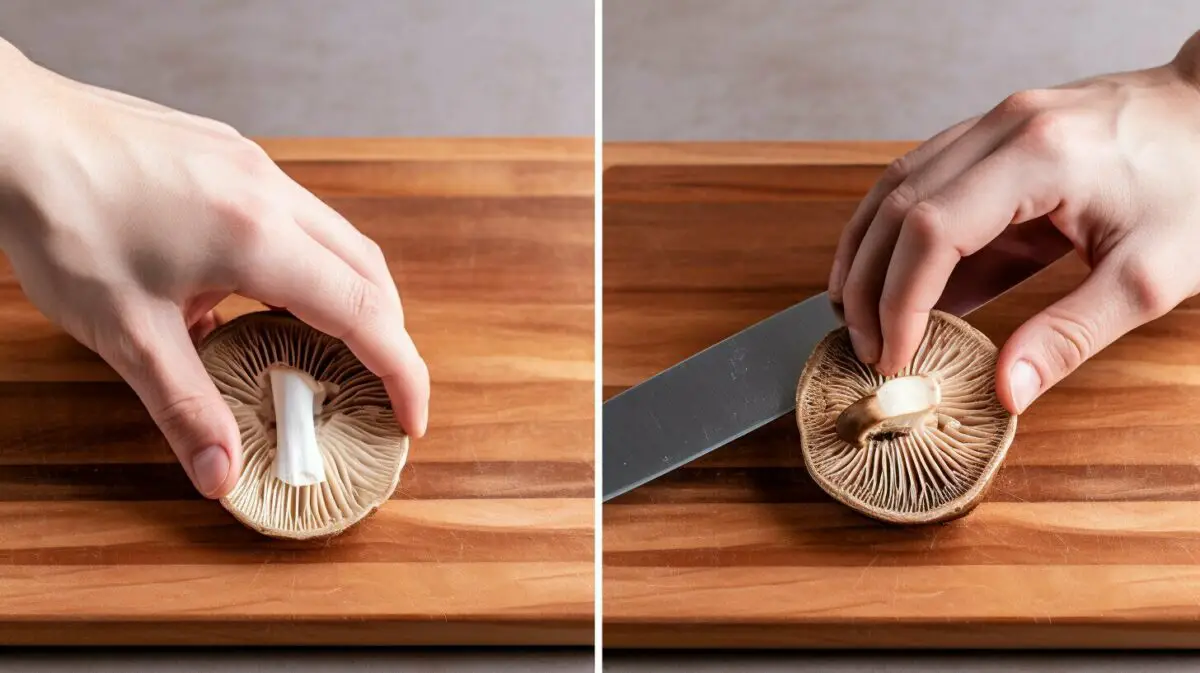
By mastering the art of quartering mushrooms, you can elevate the texture and presentation of your culinary creations. Remember to always use a sharp knife and follow proper cutting techniques for optimal results.
Dicing Mushrooms: Small and Uniform Pieces
Dicing mushrooms allows you to create small, uniform pieces that can enhance the texture and presentation of your culinary creations. Here’s how to do it properly.
To start, make sure your mushrooms are clean and dry. Wipe them gently with a damp paper towel to remove any dirt or debris. Avoid rinsing or submerging the mushrooms in water, as they can absorb moisture and become mushy.
Once your mushrooms are clean, you can begin dicing them. First, slice the mushrooms into thin, even slices. Lay the mushroom on a cutting board with the cap side facing up, and using a sharp knife, make smooth, consistent slices. Take your time and be careful to maintain a steady hand.
Next, rotate the cutting board or knife 90 degrees and cut the slices into matchstick-sized pieces. Finally, rotate the cutting board or knife again and dice the matchsticks into small, uniform cubes. The size of the cubes can vary depending on your preference and the recipe you’re preparing.
Remember to use a sharp knife for dicing mushrooms to ensure clean cuts and prevent crushing or bruising the mushrooms during the process. A chef’s knife, utility knife, or paring knife are all suitable options.
| Benefits of Dicing Mushrooms |
|---|
| Dicing mushrooms allows for consistent cooking time and even distribution of flavors throughout your dish. |
| Small, uniform pieces of mushrooms can enhance the texture and presentation of your culinary creations. |
| Diced mushrooms are versatile and can be easily incorporated into a variety of recipes such as stir-fries, soups, sauces, and more. |
So, whether you’re preparing a hearty mushroom risotto or a flavorful mushroom and vegetable stir-fry, dicing your mushrooms will ensure that they cook evenly and add a delightful touch to your dishes. Enjoy the process and unleash your creativity!

- Use firm and fresh mushrooms for easier dicing.
- Practice proper knife handling and maintain a steady hand to achieve consistent cuts.
- Experiment with different sizes of diced mushrooms to suit your recipe.
- Store any leftover diced mushrooms in an airtight container in the refrigerator for future use.
“Diced mushrooms add depth of flavor and a pleasant texture to a wide range of dishes. Take your time and enjoy the process of dicing mushrooms, as it can be a therapeutic and rewarding experience in the kitchen!”
Now that you have mastered the art of dicing mushrooms, you can confidently incorporate this technique into your culinary repertoire. Whether you’re looking to add some depth to a pasta sauce or create a beautiful garnish for your salad, diced mushrooms will elevate your cooking to new heights. Happy dicing!
| Summary of Dicing Mushrooms |
|---|
| Dicing mushrooms allows you to create small, uniform pieces that enhance texture and presentation. |
| Start by slicing the mushrooms into thin, even slices. |
| Rotate the cutting board or knife to create matchstick-sized pieces, then dice them into small cubes. |
| Use a sharp knife and store any leftovers in an airtight container in the refrigerator. |
Choosing the Right Knife for Cutting Mushrooms
Selecting the appropriate knife for cutting mushrooms is vital to ensure precision, ease, and safety. Let’s explore some key considerations and essential kitchen knife skills.
When it comes to mushroom cutting tools, there are a few options to consider. A chef’s knife is a versatile choice for most cutting tasks in the kitchen, including mushrooms. Its long, curved blade allows for smooth slices and precise cuts. If you prefer a smaller blade, a utility knife can be a good alternative. The shorter blade provides more control and maneuverability.
When handling mushrooms, it’s important to have a sharp knife. A dull blade can crush the mushrooms instead of cleanly cutting through them. Regularly sharpening your knife will ensure optimal performance. Additionally, practice proper knife skills, such as maintaining a firm grip and using a rocking motion to slice through the mushrooms with precision.
To maintain the longevity of your knife and ensure safety, it’s essential to use a suitable cutting board. Opt for a board made of wood or plastic that won’t dull the blade. Avoid using glass or ceramic boards that can damage the knife.
| Knife Type | Benefits |
|---|---|
| Chef’s Knife | Versatile, long blade for smooth slices |
| Utility Knife | Smaller blade for increased control |
By choosing the right knife and sharpening it regularly, you’ll enhance your mushroom cutting skills and make the process more efficient. Remember to practice proper kitchen knife skills, always prioritize safety, and enjoy the rewarding experience of preparing fresh mushrooms for your culinary creations.

“A sharp knife is your best friend in the kitchen. It not only makes cutting mushrooms easier but also improves the overall experience of cooking.”
Essential Kitchen Knife Skills
- Hold the knife firmly with a relaxed grip to maintain control.
- Use a rocking motion when cutting to ensure smooth, precise slices.
- Keep your fingers tucked under and away from the blade to prevent accidents.
- Always cut away from your body and work on a stable surface.
- Regularly sharpen your knife to maintain its effectiveness.
By mastering these essential kitchen knife skills and selecting the right knife for cutting mushrooms, you’ll elevate your culinary experience and create delicious dishes with ease and precision.
Creative Mushroom Cuts: Matchsticks and Julienne
If you want to add a touch of creativity to your dishes, try cutting mushrooms into matchsticks or julienne. Discover exciting ideas and various cutting styles. Whether you’re looking to elevate a salad, stir-fry, or pasta dish, these cuts can bring a unique texture and visual appeal to your meals.
Mushroom matchsticks are thin, elongated strips that resemble long, slender sticks. They add a delicate crunch and allow for even distribution throughout a dish. To create matchsticks, start by slicing the mushrooms into thin, uniform slices. Then, stack the slices together and cut them into long strips, approximately 1/8-inch wide.
Julienne is another cutting technique that produces thin, long strips, resembling thin matchsticks. It offers a more refined and elegant presentation. To achieve julienne-cut mushrooms, start by slicing the mushrooms into thin slices. Then, stack the slices and cut them into long, thin strips, approximately 1/8-inch wide.
| Mushroom Cutting Style | Description |
|---|---|
| Matchsticks | Thin, elongated strips resembling long sticks |
| Julienne | Thin, long strips resembling thin matchsticks for a refined presentation |
These creative mushroom cuts not only enhance the visual appeal of your dishes but also provide a different mouthfeel. They can be used as a topping for salads, a stir-fry ingredient, or an addition to pasta dishes. The matchsticks and julienne cuts have the advantage of cooking quickly while maintaining a firm texture.
So, if you’re ready to experiment with mushroom cutting styles, give matchsticks and julienne a try. They will add a delightful twist to your culinary creations and impress your family and friends with your culinary skills!
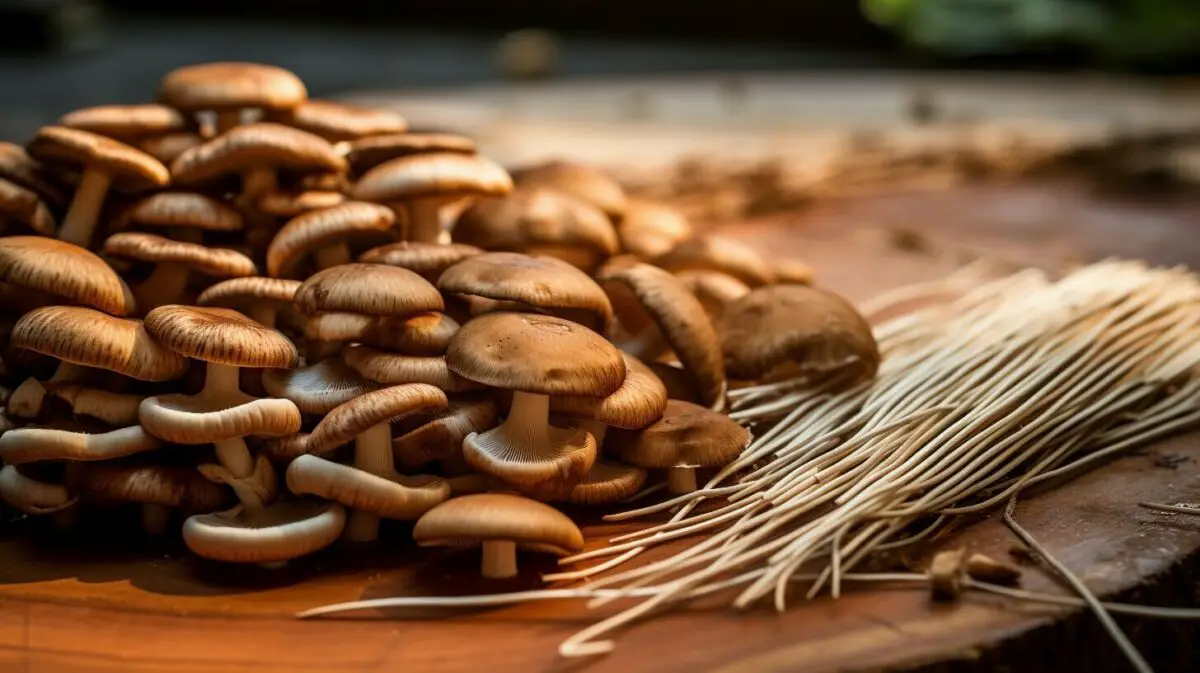
Mushroom size plays a role in recipe measurements, and understanding mushroom weight to cups conversions can help you achieve accurate results. Let’s explore the details.
When it comes to cooking with mushrooms, the size of the mushrooms you use can affect the overall outcome of your dish. Mushrooms come in various sizes, from small button mushrooms to large portobello mushrooms. Recipes often call for a specific amount of mushrooms in terms of weight or volume, so it’s essential to know how to convert between the two.
To convert mushroom weight to cups, you can use a conversion chart or follow general guidelines. As a rule of thumb, ¼ pound of mushrooms is approximately equal to 1 cup when sliced or chopped. Keep in mind that this is an estimate, and the exact conversion may vary depending on the mushroom variety and how finely you slice or chop them.
| Mushroom Weight | Mushroom Volume |
|---|---|
| ¼ pound | 1 cup (sliced or chopped) |
| ½ pound | 2 cups (sliced or chopped) |
| 1 pound | 4 cups (sliced or chopped) |
Having a good understanding of mushroom size variations and measurement conversions allows you to confidently adapt recipes based on the available mushroom sizes. Whether you’re making a mushroom risotto, a creamy mushroom soup, or a savory mushroom pie, knowing how much mushroom to use ensures that you achieve the desired flavor and texture.
Now that you’re equipped with the knowledge of mushroom size variations and measurement conversions, you can confidently explore a wide range of recipes that feature these delicious fungi. Experiment with different mushroom sizes and quantities to create exciting and flavorful dishes that showcase the versatility of mushrooms in the kitchen.
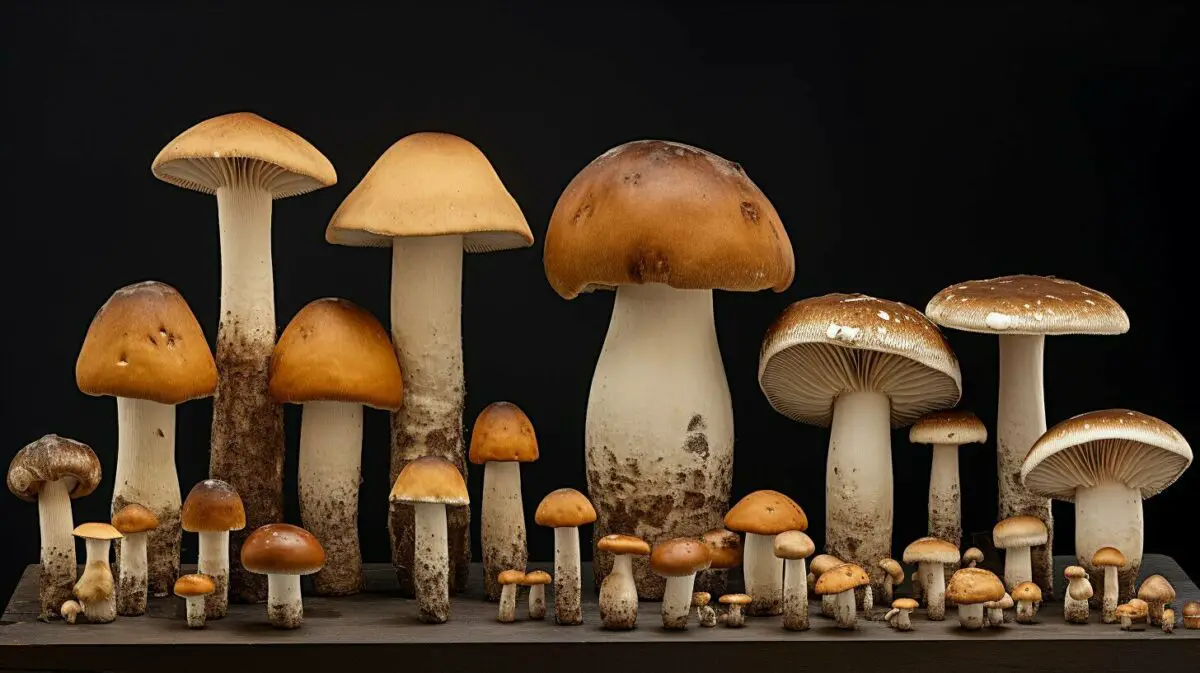
To fully enjoy the flavor and freshness of mushrooms, it’s essential to store them correctly. Here are some valuable tips to prolong the shelf life of your fresh mushrooms.
- Keep mushrooms in a vented container: Place your mushrooms in a container that allows for airflow to prevent moisture buildup. This will help maintain their freshness and prevent them from becoming slimy.
- Use a paper towel: Line the container with a paper towel to absorb excess moisture, which can cause the mushrooms to spoil faster. The paper towel will help keep them dry and extend their shelf life.
- Refrigerate promptly: Store your mushrooms in the refrigerator as soon as you bring them home. The cool temperature will slow down the growth of bacteria, helping to keep your mushrooms fresh for longer.
- Avoid washing before storage: It’s best not to rinse or submerge mushrooms in water before storing them. Mushrooms are porous and can absorb water, which can make them soggy and degrade their quality.
By following these simple tips, you can ensure that your fresh mushrooms stay fresh and delicious for an extended period.

| Storage Method | Shelf Life |
|---|---|
| Refrigerator, vented container, with a paper towel | 4-5 days |
| Freezer, properly sealed | 3-4 months |
Remember, proper storage is key to maintaining the quality and flavor of your mushrooms. By following these tips, you can enjoy their earthy goodness in your favorite dishes for an extended period.
Mushroom Nutritional Benefits: A Healthy Addition to Your Diet
Not only do mushrooms add flavor and texture to your meals, but they also offer a range of nutritional benefits that can enhance your overall well-being. Let’s explore these advantages.
Mushrooms are low in calories and fat, making them an excellent choice for those who are watching their weight. They are also rich in fiber, which aids in digestion and helps to keep you feeling full and satisfied. Additionally, mushrooms are a good source of vitamins, including vitamin D, which plays a key role in bone health and immune function. They also contain B vitamins, such as riboflavin and niacin, which are essential for energy production.
Furthermore, mushrooms are a natural source of antioxidants, including selenium and ergothioneine. These antioxidants help to protect your body’s cells from damage caused by free radicals, which can contribute to chronic diseases such as cancer and heart disease. In fact, some studies have suggested that mushrooms may have anti-inflammatory properties and could potentially help to reduce the risk of certain types of cancer.
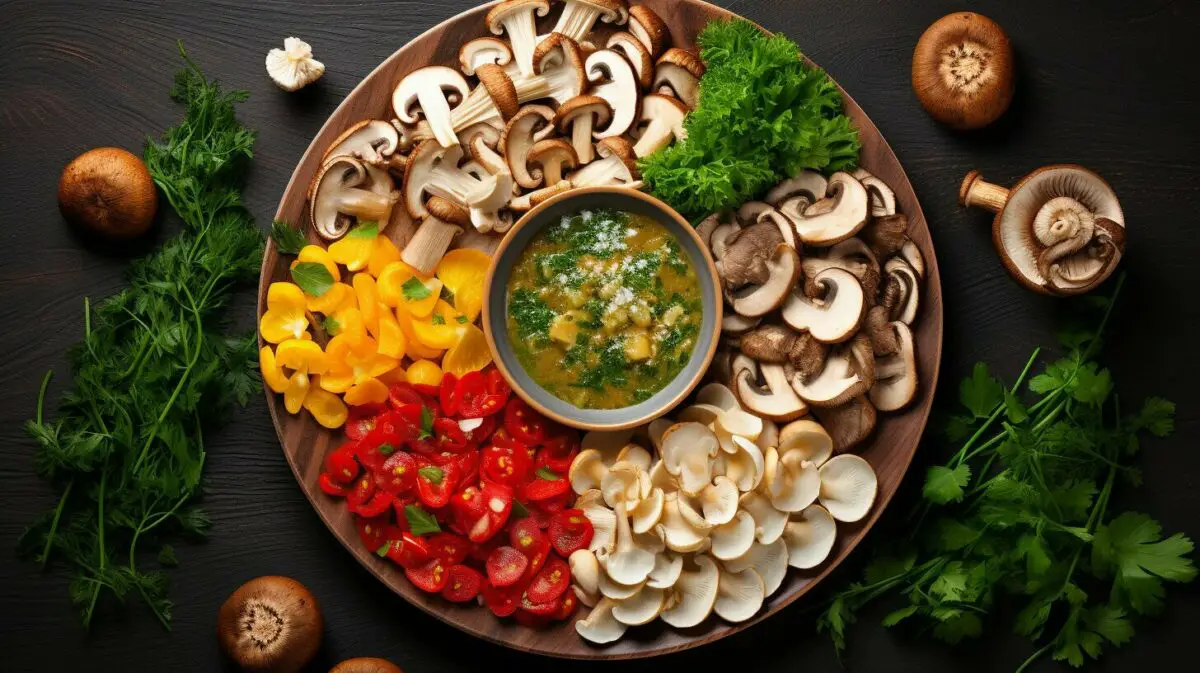
In addition to their antioxidant content, mushrooms are also packed with minerals such as potassium, copper, and zinc. Potassium is essential for maintaining healthy blood pressure levels, while copper is important for the production of red blood cells and zinc supports a healthy immune system.
To reap the maximum nutritional benefits from mushrooms, it’s important to cook them properly. While mushrooms can be enjoyed raw in salads or as a garnish, cooking them can actually enhance their nutritional profile. Heating mushrooms helps to break down their tough cell walls, making it easier for your body to absorb the nutrients they contain. So, whether you sauté them, grill them, or roast them, cooking mushrooms can unlock their full potential.
Incorporating Mushrooms into Your Diet
There are countless ways to incorporate mushrooms into your diet. You can add them to stir-fries, soups, omelets, or pasta dishes for an extra burst of flavor and nutrients. They can also be used as a substitute for meat in vegetarian or vegan recipes, thanks to their hearty texture and umami flavor.
When selecting mushrooms, opt for fresh ones that are firm, plump, and free from blemishes. Store them in a paper bag in the refrigerator, as this will help to extend their shelf life. Before using them, give them a quick rinse and pat them dry with a paper towel to remove any dirt or debris.
So, the next time you’re planning a meal, consider adding mushrooms to the menu. Not only will they add depth and richness to your dishes, but they will also provide you with a range of nutritional benefits that can support your overall health and well-being.
| Nutrient | Amount per 100g |
|---|---|
| Calories | 22 |
| Protein | 3g |
| Fat | 0g |
| Carbohydrates | 3g |
| Fiber | 1g |
| Potassium | 396mg |
| Vitamin D | 5µg |
| Riboflavin (B2) | 0.4mg |
| Niacin (B3) | 3.6mg |
| Selenium | 20µg |
Mushroom Origin and History: Fascinating Fun Facts
Mushrooms have a rich and fascinating history that dates back centuries. Discover the origin and uncover some surprising fun facts about these versatile ingredients.
| Fun Fact 1: | Mushrooms have been consumed for thousands of years, with evidence of their use dating back to ancient civilizations such as the Egyptians, Greeks, and Romans. They were highly regarded for their medicinal properties and were believed to possess mystical and healing powers. |
|---|---|
| Fun Fact 2: | Did you know that mushrooms are not plants, but actually fungi? They belong to their own kingdom, separate from plants and animals. Mushrooms reproduce by releasing spores, similar to how plants produce seeds. |
| Fun Fact 3: | Some mushrooms have unique properties, such as the ability to glow in the dark. The phenomenon, known as bioluminescence, occurs due to a chemical reaction within the mushroom’s cells. It’s a breathtaking sight to behold! |
Another fascinating fact is that mushrooms have been used in various cultures for spiritual and religious purposes. They have been associated with rituals, visions, and altered states of consciousness. Certain species, such as psilocybin mushrooms, contain hallucinogenic compounds that can induce profound experiences.
“Mushrooms are nature’s little marvels, offering a world of culinary delights and a journey into ancient history.” – [Your Name]
The Alluring World of Mushroom Varieties
- Agaricus bisporus: This is the most commonly cultivated mushroom worldwide and includes both white button mushrooms and cremini mushrooms. They are mild and versatile, making them a staple in many recipes.
- Pleurotus ostreatus: Also known as oyster mushrooms, these beauties have a delicate, earthy flavor and a velvety texture. They come in various colors, including white, grey, and yellow, and are perfect for stir-fries and soups.
- Lentinula edodes: Popularly known as shiitake mushrooms, they have a rich, smoky flavor and are commonly found in Asian cuisine. Shiitake mushrooms are highly nutritious and can be used in a variety of dishes, such as stir-fries, broths, and stews.
These are just a few examples from a vast array of mushroom varieties available today. Each type brings unique flavors, textures, and nutritional profiles to the table, making mushrooms a truly exciting ingredient to explore.
Mushrooms truly are nature’s little marvels, offering a world of culinary delights and a journey into ancient history. From their mysterious origins to their various uses in different cultures, mushrooms continue to captivate our imagination. So the next time you’re savoring a mouthwatering mushroom dish, take a moment to appreciate the fascinating story behind these versatile ingredients.
Mushroom Recipes: Explore the Culinary Possibilities
Ready to put your newfound mushroom cutting skills to use? Explore a collection of delicious mushroom recipes and gain some valuable kitchen tips along the way. Mushrooms are incredibly versatile and can be used in a wide range of dishes, from appetizers to main courses and even desserts. Whether you’re a vegetarian looking to add some flavor and texture to your meals or a meat lover seeking to enhance your dishes, mushrooms can be the perfect ingredient to elevate your culinary creations.
One popular mushroom recipe is the classic Mushroom Risotto. Made with Arborio rice, butter, Parmesan cheese, and, of course, mushrooms, this creamy and comforting dish is a crowd-pleaser. Saute the mushrooms in butter, along with some garlic and onions, before adding the rice and gradually incorporating hot vegetable or chicken broth. Top it off with freshly grated Parmesan cheese, and you have yourself a delicious and satisfying meal.
| Recipe | Ingredients | Instructions |
|---|---|---|
| Mushroom Risotto |
|
|
In addition to savory dishes, mushrooms can also add a unique twist to desserts. For a sweet treat, try making a Mushroom Chocolate Truffle Cake. This decadent cake combines the richness of chocolate with the earthy flavors of mushrooms for a truly indulgent dessert. The finely chopped mushrooms blend seamlessly with the chocolate, creating a moist and flavorful cake that will impress any chocolate lover.
Mushrooms are like little flavor bombs in your dishes, adding depth and richness to both savory and sweet recipes.” – Jane Doe, Chef and Cookbook Author

So, let your creativity run wild in the kitchen and explore the culinary possibilities of mushrooms. From soups and stews to pastas and pizzas, mushrooms can take your cooking to a whole new level. Remember to experiment with different types of mushrooms, such as cremini, shiitake, or portobello, to discover new flavors and textures. Whether you’re a seasoned chef or a beginner in the kitchen, mushrooms offer endless opportunities to create delicious and satisfying meals.
How to Cut Mushrooms – Conclusion
Cutting mushrooms is a simple yet significant step in your culinary journey. By mastering these techniques and embracing the preparation process, you can elevate your dishes to new heights.
When it comes to cutting mushrooms, the options are endless. Whether you prefer slices, quarters, cubes, or dices, each cutting method provides a unique texture that can enhance the flavors and presentation of your dishes. Remember to choose a sharp knife that suits your preference, be it a chef’s knife, utility knife, or paring knife.
Once you’ve mastered the art of mushroom cutting, you can explore a world of culinary possibilities. From stir-fries to soups, sauces, and more, mushrooms add depth and richness to countless recipes. To ensure freshness, store your mushrooms in a vented container lined with a paper towel in the refrigerator for up to 4-5 days.
Not only are mushrooms delicious, but they also offer numerous health benefits. Packed with vitamin D, zinc, and potassium, they make a nutritious addition to any diet. So next time you’re in the kitchen, don’t underestimate the power of proper mushroom cutting and preparation. Your taste buds and body will thank you!
How to Cut Mushrooms – FAQ
Q: How do I clean mushrooms before cutting them?
A: Wipe the mushrooms with a damp paper towel to remove dirt and debris. Avoid rinsing or submerging them in water to prevent them from becoming mushy.
Q: What are the different ways to cut mushrooms?
A: Mushrooms can be sliced into thin slices, quartered for a chunkier texture, or diced into small pieces. You can also cut them into matchsticks or julienne for creative presentation.
Q: How should I slice mushrooms?
A: Lay the mushrooms on a cutting board with the cap side facing up and use a sharp knife to make even, thin slices.
Q: How do I quarter mushrooms?
A: Slice the mushroom in half, rotate it 90 degrees, and slice it in half again to achieve quartered mushrooms.
Q: What is the process of dicing mushrooms?
A: Slice the mushrooms into matchsticks, rotate the cutting board or knife 90 degrees, and dice the matchsticks into small pieces.
Q: What knife should I use to cut mushrooms?
A: You can use a chef’s knife, utility knife, or paring knife as long as the knife is sharp.
Q: How long can I store fresh mushrooms?
A: Store fresh mushrooms in a vented container lined with a paper towel in the refrigerator. They can last for 4-5 days when stored this way.
Q: Are mushrooms a healthy addition to my diet?
A: Yes, mushrooms are a good source of vitamin D, zinc, and potassium, making them a healthy addition to any diet.
Our Friends:
Related Recipes:
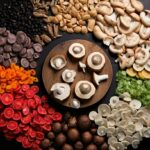 Types of Mushrooms: How to Use Them? (Guide)
Types of Mushrooms: How to Use Them? (Guide)
 How to Cut a Tomato? (Perfect Step-By-Step Guide)
How to Cut a Tomato? (Perfect Step-By-Step Guide)
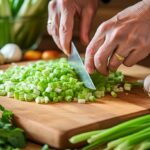 How to Cut Green Onions? (Step-By-Step Guide)
How to Cut Green Onions? (Step-By-Step Guide)
 How to Cut a Watermelon? (Perfect Step-By-Step Guide)
How to Cut a Watermelon? (Perfect Step-By-Step Guide)
 How to Cut Dragon Fruit? (Perfect Step-By-Step Guide)
How to Cut Dragon Fruit? (Perfect Step-By-Step Guide)
 How to Cut Carrots? (Perfect Step-By-Step Guide)
How to Cut Carrots? (Perfect Step-By-Step Guide)
 How to Cut Beets? (Perfect Step-By-Step Guide)
How to Cut Beets? (Perfect Step-By-Step Guide)
 How to Cut an Orange? (Step-By-Step Guide)
How to Cut an Orange? (Step-By-Step Guide)


